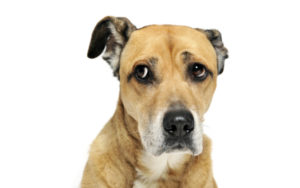
Dogs have very keen senses, especially hearing and smell. While these gifts help them survive, they can also leave them vulnerable to developing fear associations. Additional causes of phobias in dogs include genetics, lack of proper socialization, and previous negative experiences.
The frightening stimuli listed below are among the most common fears and phobias in dogs.
As you can see, each has a profound effect on one or more of their senses.
1. Thunderstorms
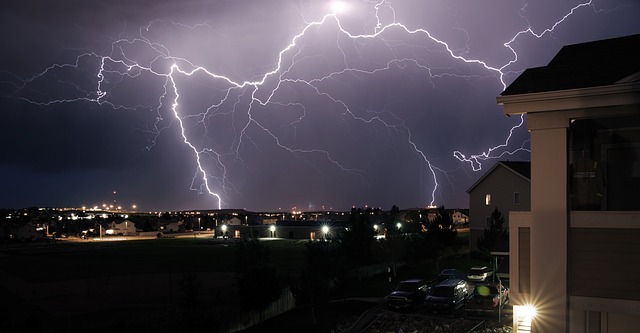
There are a few reasons thunderstorms inspire terror in so many dogs. The most obvious is the noise. Dogs’ hearing is two to three times more sensitive than our own. For them, the booms of a summer storm are far louder, far closer, and far more jarring.
Recent studies have found that the loud cracking sound of thunder is just a small part of what makes storms one of the most common phobias in dogs. Thunderstorms also alter the atmosphere, releasing a large amount of static electricity into the air. Dogs experience this static as a tingling throughout their hair coat and may even receive multiple shocks before the storm lifts.
According to Dr. Nicholas Dodman, director of the Animal Behavior department at the Cummings School of Veterinary Medicine at Tufts University, this is why many dogs flee to grounded areas of the home during thunderstorms. Basements, bathtubs and enclosed spaces tend to have less static electricity.
Dodman, Vetstreet’s Dr. Marty Becker, and many veterinarians around the world agree that rubbing your dog’s coat with a dryer sheet can be quite effective at minimizing static. However, they recommend doing this infrequently and using an unscented brand to reduce your dog’s exposure to potentially harmful chemicals.
2. Fireworks

Much like thunderstorms, fireworks are one of the most common phobias in dogs. In fact, a 2013 study by the University of Bristol’s School of Veterinary Sciences found them to be the number one trigger for fearful behavior. Not only are fireworks extremely loud, they also cause frightening odors and visual effects.
In addition to the sensory component, some scientists feel there is a genetic aspect to noise phobias in dogs. A 2015 study conducted by the Norwegian University of Life Sciences in Oslo found a “marked correlation” between breeds and noise-sensitive fearfulness.
If your dog suffers from noise phobias, you will be happy to learn that many pet professionals oppose the theory that comforting fearful dogs reinforces their fear. Veterinary behaviorist Melissa Bain told the New York Times:
“You can’t reinforce anxiety by comforting a dog….You won’t make the fear worse. Do what you need to do to help your dog.”
3. Car Rides
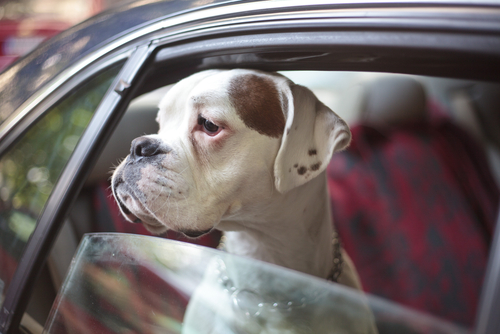
Aside from the fact that cars are big, loud, and move way too fast, they can also cause motion sickness in canine passengers. No wonder riding in cars is high on the list of common phobias in dogs!
It can be difficult to tell the difference between car sickness and true vehicle anxiety so most experts recommend addressing both. Desensitization training and anti-anxiety medications are helpful for fearful pups, but motion sickness is a bit more complicated.
Protect your dog from nausea in the car by restraining him in a forward-facing carseat, seatbelt or crate. This prevents the dizzying effect of seeing objects whiz past in the wrong direction. It may also help to crack a window in order to equalize the air pressure inside the vehicle. If you do not wish to medicate your dog, try withholding food for several hours before a drive.
4. Stairs
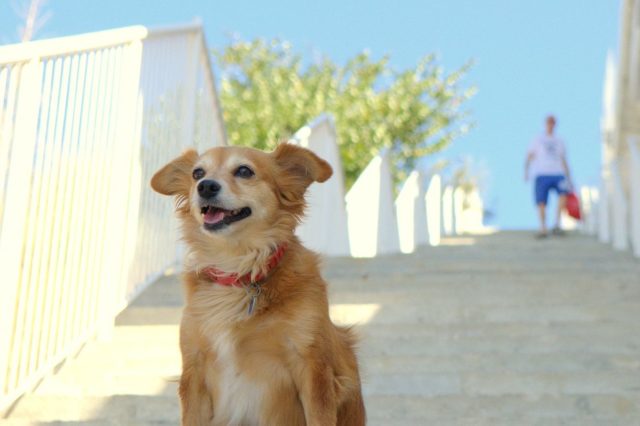
There are four main reasons dogs may be fearful of stairs. One, a lack of exposure in their younger days has left them with a fear of the unknown. Two, they had a traumatic experience on or near a staircase. Three, they have been restricted from using the stairs in the past, causing a negative association to form. And finally, a medical condition like arthritis or hip dysplasia makes climbing stairs difficult or painful.
Whatever the cause of this prevalent dog phobia, a combination of counter-conditioning, desensitization, and plenty of patience can help your pup overcome it.
5. The Vet
In humans this phobia is sometimes referred to as “white coat syndrome.” Feeling nervous when faced with poking, prodding and potentially scary medical news is normal for us, but this phobia in dogs is more about sensory overload.
A veterinary office is full of new and frightening sights, sounds, smells and sensations. In addition to the volume of stimuli coming at them, our intuitive pups can sense the fear and pain of the other animals and perhaps even the grief of the human in the room next door.
If visits to the vet are a source of fear for your dog, try stopping by for non-medical visits. Plan ahead so the staff knows you are coming and ask them to love on your pup, play with him, and offer his favorite treats. A few of these “happy visits,” will hopefully teach your dog that the vet staff are not out to get him!
6. Being Alone

Several factors can trigger separation anxiety in dogs including abandonment, death of a previous owner, moving to a new home, or experiencing a drastic change in their schedule or lifestyle. There is also evidence that certain breeds have a genetic predisposition for this type of phobia.
Celebrity dog trainer, Victoria Stillwell lists herding breeds among the most likely to develop a fear of being alone.
“I think they’re bred to be so sound sensitive and to be environmentally sensitive,” she said in an interview with Web MD Pets. “You’ll find that Collies and Shelties and even German Shepherds can be predisposed to suffering very much from fears and anxieties. It’s almost like they’re wired in a different way. They are hyper-aware.”
That’s not to say that every Border Collie will have separation anxiety or that non-herding breeds are happy when left alone. Separation anxiety and the destructive behaviors that accompany it can occur in any dog at any time. What matters is how you respond to it.
7. People
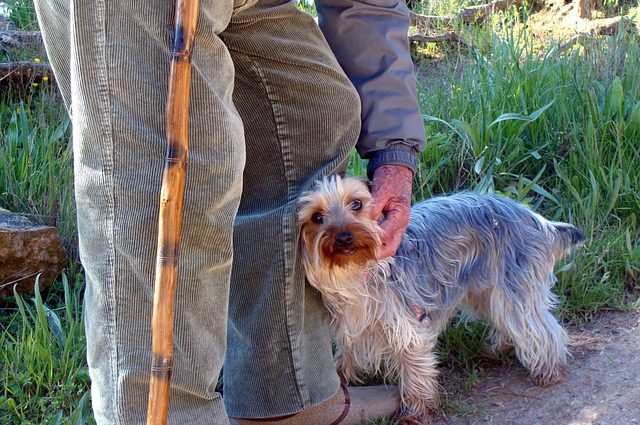
Our pups are social animals so it is quite rare for them to be frightened of all humans unless they have been severely abused or neglected. However, the fear of specific humans is a prevalent phobia in dogs.
While their reactions may seem arbitrary, there is usually a very distinct trigger they are responding to. They may get nervous around men with deep voices, boisterous children, women wearing too much perfume, or any other combination of factors.
For this reason, dog trainers and veterinary professionals recommend socializing your dog early and often. They suggest providing your dog with 100 positive exposures in the first 100 days they are with you. This includes all kinds of people, places and things.
Like separation anxiety, nervousness around strangers can be an inherited trait, but research shows proper socialization can overcome genetics. Even adult rescue dogs can become well socialized with a bit of extra effort.
Note: Ask your vet if your puppy’s immune system is developed enough before heading out in public.
8. Other Dogs

The fear of dogs is another phobia often connected to a pet’s level of exposure to social situations. A dog’s first lessons in socialization come from its mother and littermates. Puppies separated from their birth families too soon miss out on vital interactions with their own kind at a crucial time in their development.
Fear and/or aggression towards other dogs can also develop as the result of trauma. One bad interaction is often enough to taint all future encounters. Unfortunately, there is no set protocol for overcoming past trauma, but the tips in this post may help.
Fear of their own kind is one of the most difficult phobias in dogs because it is easily reinforced by well-meaning owners. Many pup parents become overly protective in situations that frighten their beloved dogs. They may tense up on the leash, yell, or scoop up their pooch when another dog approaches.
Because this phobia can be quite complicated and potentially dangerous, consider seeking the help of a professional trainer. He or she can help rehabilitate your pup and slowly work up to positive interactions with other dogs.
9. Grooming
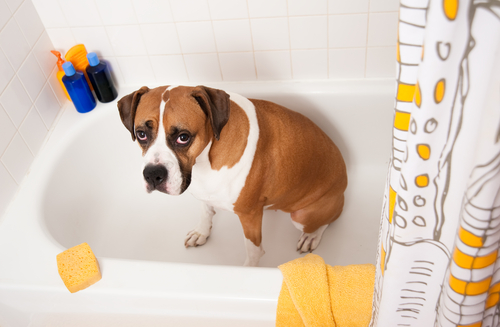
While some dogs thoroughly enjoy a good bath and the way they feel after a haircut, others find grooming terrifying. Like many of the other phobias listed, the fear of grooming likely occurs when a dog is overwhelmed by sensory input.
Grooming shops can be chaotic and are packed with the sights, sounds and smells of other excited/nervous dogs. In addition, pups that dislike water or are not comfortable with body handling may struggle during their bath and trim.
Jennifer Nelson, iHeartDogs’ veteran groomer, recommends pinpointing your dog’s individual triggers – separation anxiety, noisy equipment, spending time in a cage, etc. – and customizing your grooming appointment accordingly.
10. Unfamiliar Objects

This category covers a broad range of phobias in dogs. From motorcycles to the dreaded vacuum cleaner, dogs often react fearfully to objects that make strange noises or move in ways they do not understand.
Many dogs are terrified of umbrellas, balloons, ceiling fans – even animatronic fish!
Typically, these phobias stem from a fear of the unknown. One of my dogs was rescued from a backard breeding operation and spent most of his life in a cage. It took several years to desensitize him to all the new stimuli in the outside world.
He was scared of cars, hats, plates, forks, the dishwasher, the microwave, the vacuum – anything noisy or odd-looking. While he is still a bit timid and cautious in certain situations, lots of patience and careful exposure therapy helped him become a happy, well-adjusted pup!
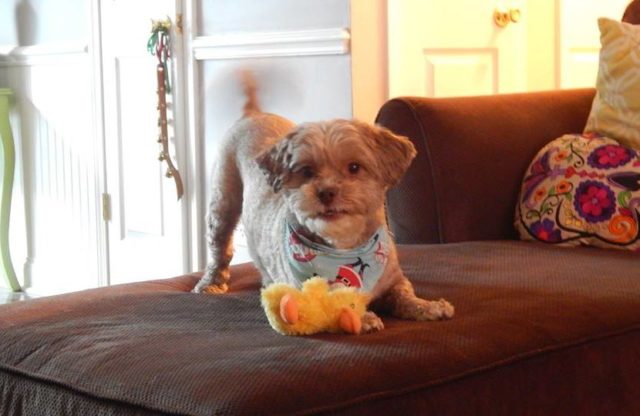
Phobias in dogs can be quite serious, leading to aggression, destructive behavior, and a decreased quality of life. If your dog is suffering from a fear of any of these common stimuli, contact a veterinary behaviorist or a professional trainer. You may also find these tips on helping your dog overcome his fears helpful.
The post 10 Of The Most Common Fears And Phobias In Dogs appeared first on iHeartDogs.com.
from iHeartDogs.com https://ift.tt/2xLm4Fr



No comments:
Post a Comment